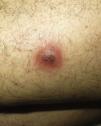Staphylococcus lugdunensis belongs to the group of coagulase negative staphylococci (CoNS) that are members of the skin microbiota. In contrast to the other CoNS, S. lugdunensis presents microbiological characteristics associated with a high level of virulence and a capacity to produce suppurative infections, in both healthy and immunodepressed individuals.1 An increase in the incidence of community acquired infections has been reported in recent years, with the skin and subcutaneous cellular tissue being the main targets.
We present 2 cases of pyoderma in which S. lugdunensis was isolated as the causative agent.
The first patient was a 59-year-old man with type 2 diabetes. He consulted for a lesion that had arisen on the left thigh several weeks earlier and that he attributed to an insect bite. He did not report fever. Examination revealed a violaceous nodule of 2cm diameter with a central orifice through which purulent material was draining. The lesion was clinically compatible with an abscess (Fig. 1). Surgical drainage was performed and samples were taken for microbiological analysis. Home treatment consisted of the application of fusidic acid cream twice a day after wound cleansing. The lesion healed in a week. S. lugdunensis was isolated from the culture (identification by MicroScan); the organism was sensitive to ampicillin, oxacillin, and to the other antibiotics tested (gentamycin, erythromycin, clindamycin, vancomycin, rifampicin, fosfomycin, trimethoprim-sulfamethoxazole, ciprofloxacin, norfloxacin, and daptomycin; antimicrobial sensitivity assay: broth microdilution).
The second patient was a woman aged 42 years with no past medical history of interest. She consulted for a painful lesion that had arisen a month earlier on the sole of the right foot. She did not recall any injury, but there had been superficial manipulation by a podologist before the discomfort started. On examination, a whitish plaque was observed that did not disrupt the dermatoglyphs. Curettage of the hyperkeratotic component revealed an abscessified cavity. Surgical lavage was performed and samples were sent for microbiology culture, from which S. lugdunensis (MicroScan) was isolated, showing an antimicrobial sensitivity pattern identical to that of the previous case. Antibiotic treatment with initiated with amoxicillin/clavulanic acid 875mg/125mg every 8hours and 2% mupirocin cream twice a day for a week, with a satisfactory clinical course.
The growth of CoNS in skin cultures can typically be explained by its presence as a commensal organism. However, some species are associated with a higher risk of developing suppurative infections. In recent years, S. lugdunensis has been shown to be one of the main CoNS with pathogenic potential. It was first described by Freney et al. in 1988. The term lugdunensis derives from the city where the organism was first isolated: Lugdunum, the Latin name for Lyon, France.
This staphylococcus has been described by some authors as a wolf in a lamb's skin”,2 because of its high virulence and its ability to act as a pathogenic organism, in contrast to other CoNS.
Although it can affect healthy individuals, the risk is higher in patients with diabetes mellitus, kidney failure, or malignant disease, and in those on immunosuppressant treatment. Trauma or a solution of continuity after surgery are the main pathological states associated with infection by this microorganism.3,4
As a colonizing organism, S. lugdunum is found in areas rich in apocrine sweat glands, such as the inguinoperineal and periareolar regions,5 although it can also be isolated from the nares of healthy individuals.
Clinical infection typically presents as skin and soft tissue infection in the form of a subcutaneous abscess. Nonpuerperal mastitis—often recurrent—warrants special mention.6 Bone and joint infection can arise by contiguous spread, highlighting the pathogenic potential of this staphylococcus. Less commonly, it has been associated with infections of the central nervous system7 or urinary tract and with endocarditis.8
Its high virulence compared with other CoNS is due to a number of characteristics: the formation of a biofilm (it is also an emerging pathogen in prosthesis-related infections), production of adherence proteins, resistance to high concentrations of lysozyme, and production of heat-stable hemolysin.2,9 However, it does not produce Panton-Valentine leukocidin, the toxin responsible for the virulence of some strains of Staphylococcus aureus.
In contrast to other SCoN, S. lugdunensis presents an excellent sensitivity profile to a number of families of antimicrobials, including the penicillins, which makes control easier. Despite this, cases of methicillin resistance have already been reported.10
It should be noted that the rate of error of identification in automated instruments is not insignificant, meaning that the frequency of infection may be underestimated.
The growing interest in this bacterium in dermatology is based not only on its elevated capacity to cause skin and soft tissue infections, but also on the correct interpretation of the culture, in order to recognize it as a pathogenic organism and not rule it out as a skin comensal.
Please cite this article as: Lozano-Masdemont B, Gómez-Recuero-Muñoz L, Pulido-Pérez A. Staphylococcus lugdunensis: un patógeno emergente en infecciones de piel y partes blandas. Actas Dermosifiliogr. 2015;106:769–770.






